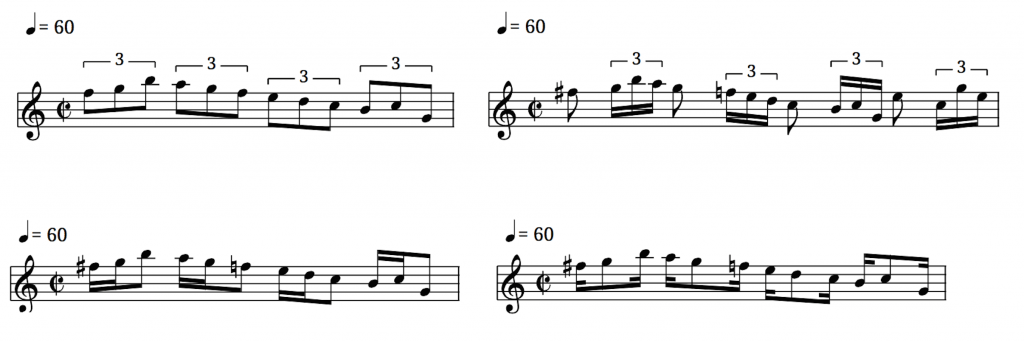-
×
 Anche hautbois étudiant (débutant) EG-REEDS
1 × 10,90€
Anche hautbois étudiant (débutant) EG-REEDS
1 × 10,90€
Sous-total: 10,90€
Here are some small tips that I hope will help you study « La scala di seta » by Rossini. I leave you my version, which I played when I was oboe soloist in « Guiyang Symphony Orchestra » (China) to know what we are going to talk about.
Éric González, oboe soloist.
When practicing « La Scala di Seta » or any orchestral excerpt (in the technical part), the main thing is to look for the problems that we will find and how to solve them.
The basic problems presented in the fast part of « La Scala di Seta » are:
1- Clear and precise articulation for a prolonged period
2- Synchronized fingering and articulation
When we find excerpts of this type, the most effective is to work the problems separately to later join them. We will first put our attention on the fingering and for the moment we forget the articulation. This allows us to know what is the main problem in our case. It also allows us to identify which passages offer greater difficulty for fingering and work them in a more focused way. Needless to say it is always essential to work with the metronome.
We will start working with all legato as shown in the example, increasing the speed progressively as we progress.

Once you master the previous exercise you can begin to study the fingers with different rhythms as shown in the following example. You can use as many rhythms as you can imagine, but it always has to be very precise.
 Once practiced with different rhythms and speeds, it’s time to start studying articulation. This entry is for oboists who already master double tongue. Soon I will write another post about how to study double tongue for students who start in it. But of course this solo can be played with single tongue as well if your single tongue is fast enough.
Once practiced with different rhythms and speeds, it’s time to start studying articulation. This entry is for oboists who already master double tongue. Soon I will write another post about how to study double tongue for students who start in it. But of course this solo can be played with single tongue as well if your single tongue is fast enough.
Before starting with articulation, whether it is simple or double, I always like to use this simple but effective exercise to warm up the muscles.
 As in the study of fingering, in the articulation we will always use the metronome and also different rhythms. You have to be especially careful with the precision of the rhythms and the tongue. Do not try to increase the speed of the metronome very fast. Think that this is a job of months or even years.
As in the study of fingering, in the articulation we will always use the metronome and also different rhythms. You have to be especially careful with the precision of the rhythms and the tongue. Do not try to increase the speed of the metronome very fast. Think that this is a job of months or even years.

The rhythmic options are endless, whether you use simple or double tongue. Try to find different rhythms. You can also mix different articulations.
 Here are some rhythmic examples that you can apply to both fingering and articulation exercises.
Here are some rhythmic examples that you can apply to both fingering and articulation exercises.

I hope all these tips serve you both for this solo and for studying double tonguing on the oboe. Remember that it is a job that requires patience and perseverance.
If you want you can leave us your comment with more ideas of posts that interest you.
See you at www.eg-reeds.com !
Anche hautbois Pro 901
Anche hautbois Pro M2
Hautbois intermédiaire EG-REEDS
Anche hautbois Mayer
Hautbois étudiant débutant EG-REEDS
Roseaux taillés hautbois EG-REEDS
Anche hautbois étudiant (débutant) EG-REEDS
Anche cor anglais Pro EG-REEDS
François Leleux
Nov
Maurice Bourgue
Mar
Le hautbois dans la musique de film
Mar
Albrecht Mayer
Fév
Anches de hautbois : l’anche idéale pour chaque étape
Jan
Comment acheter le meilleur hautbois pour les étudiants?
Jan
Heinz Holliger
Jan
Joyeux Noël et Bonne Année 2025 !!
Déc